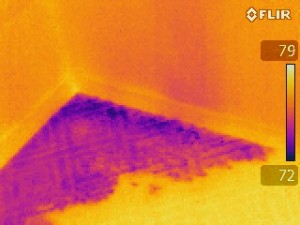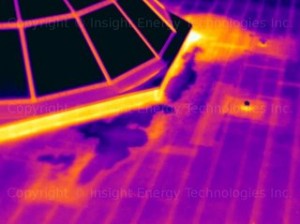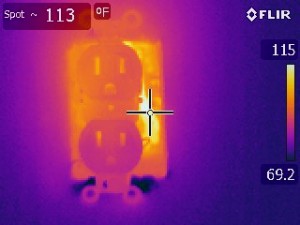How can this technology be useful?
Moisture Detection in Walls and Ceilings – As demonstrated above, thermal imaging is a great tool that helps to identify water damage in walls, floors, and ceilings. By detecting the difference in temperature between a wet area and the surrounding dry areas, thermal imaging can help detect moisture issues that would not be visible during a limited visual home inspection. It is also great at identifying areas where the insulation contractor failed to insulate adequately.
Plumbing Inspections – Water leaks from the plumbing system are often undetected until major damage has occurred. We can scan in, under, and around plumbing fixtures in the home to determine if there is an active leak. Since this tool is not a moisture meter, we will use it to find heat anomalies and then pursue the issue further to attempt to determine the source and cause of the leak.
Thermal image scanning can detect temperature anomalies in the plumbing system not visible to the naked eye that may be a precursor to a larger issue. The resulting Thermal Image Scan report can be a great aid for the repair plumber hired to address the identified issues.
Stucco & EIFS Inspections – Thermal image scanning has greatly improved our ability to perform stucco and EIFS moisture intrusion inspections. If there is rot behind the stucco, it is often visible with thermal imaging in the form of heat anomalies. Thermal image scanning also helps to quantify the affected areas of moisture damage. By adding this tool to our stucco inspections, we have been able to better identify where the trouble areas are that need repair.
Wood Destroying Insect Activity – Significant wood destroying insect activity can be detected using this technology due to the heat generated by active infestations. That’s right, active termite activity produces a great deal of heat that is often visible to the infrared camera. Minor activity may not be detectable. However, areas not that are not visible can be identified and then a more invasive or technically exhaustive inspection can be carried out by the appropriate professional.
Energy Audits – We do not currently specialize in performing energy audits, but thermal imaging has been a great tool to help homeowners save money, especially since energy rates are rising. Heat loss and/or cold air influx can be detected and corrected to help improve the energy efficiency of residential and commercial structures.
Once the energy-wasting areas are identified, changes can be made to make a dramatic difference in energy consumption which means less money out of pocket.
Flat Roof Inspections – If you have a leak on a new- to mid-life flat roof and you have been told that a new roof is needed, call us first. We may be able to save you a substantial amount of money. Thermal imaging can be used to detect the precise location of the leak and mark the affected area so that repairs can be made to the leaking area. Obviously, if the roof is older, then you should forego the thermal imaging and invest in the needed new roof.
Electrical Inspection – Abnormal heating associated with high resistance or excessive current flow is the main cause of many problems in electrical systems. Infrared thermography allows us to see these invisible thermal signatures of impending damage before the damage occurs. When current flows through an electric circuit, part of the electrical energy is converted into heat energy. This is normal. But, if there is an abnormally high resistance in the circuit or abnormally high current flow, abnormally high heat is generated. This is wasteful, potentially damaging, and not normal.
Infrared electrical inspections find hot spots caused by defects in connections and components. Infrared thermography is used to find areas of excess heat (caused by increased resistance) so that problems can be corrected before a component fails, causing damage to the component, creating safety hazards and productivity loss. Because increased heating is a sign of failure, infrared is the best diagnostic tool available for finding these hot connections in the early stages of degeneration.
Loose or dirty electrical connections and other electrical anomalies can cause power outages and possible fires. We can inspect the electrical panels and receptacles to detect issues before there is a costly outage. Thermal imaging can detect hot spots in the electrical system not visible to the naked eye which may be a precursor to a larger issue. The resulting report can be a great aid for the repair electrician hired to address the identified issues.
What Thermal Image Scanning is NOT?
MOISTURE METER – The infrared thermal imaging camera is NOT a moisture meter. It simply identifies thermal anomalies. This device greatly aids in identifying areas that need further investigation.
X-RAY VISION – The infrared thermal imaging camera is NOT an X-ray vision scope. It does not provide the user with an immediate Superman S on their chest with the ability to clearly see inside walls. Instead, it identifies thermal differences.
SILVER BULLET – The infrared thermal imaging camera is NOT a silver bullet solution, but when it is used in conjunction with other technologies thermal imaging has helped us to identify issues that are rarely identified during the limited visual home inspection process.
RISK ELIMINATOR – The infrared thermal imaging camera does NOT completely remove the risks of concealed damage.
PLEASE NOTE: It is deceptive to claim that thermal imaging detects moisture because the best that it can do is detect thermal differences. Using the infrared camera to help discover moisture issues are helpful because once the anomalies are identified, then moisture meters and other diagnostic tools can be used to identify the source of the anomaly.
Moisture equals mold – Whenever a leak and moist conditions exist longer than 72 hours, mold can form. This fact is a reality and the infrared camera can quickly and in a non-invasive manner help identify these issues. But remember, the infrared camera identifies the heat signatures and does not measure the moisture content.
Why Thermal Imaging?
There are quite a few hidden defects that can be discovered with the use of thermal imaging that an inspector cannot observe during a normal visual-only inspection. Moisture is one of the biggest issues that get revealed during an inspection using thermal imaging; related moisture problems are often roof leaks, hidden condensation problems, and leaky shower enclosures. Electrical problems are also revealed as well as heating and cooling energy loss, HVAC air leaks, foundation cracks, structural concerns, missing insulation, ventilation glitches, and rodent/pest infestations.
Benefits of thermal imaging in the detection of:
- Roof Leaks (roof leaks located with recent rainfall within 24-48 hours)
- Moisture in stucco
- Cold air infiltration
- Excessive moisture in building materials
- Leaking plumbing, tub, and shower enclosures
- Missing insulation or insulation gaps, insufficient and unevenness
- Overheating electrical components: wiring, panels, breakers, switches, and wire connections
-
- Especially important if the home has aluminum electrical wiring and components
- Heating and cooling duct placement, insulation, air leaks
- Pipe location
Contact A-Action Realty Inspection Services to get started with your thermal imaging inspection or get a regular real estate inspection for your Dallas home. We invite you to get in touch with us, get a quote, or go ahead and schedule your inspection now.






